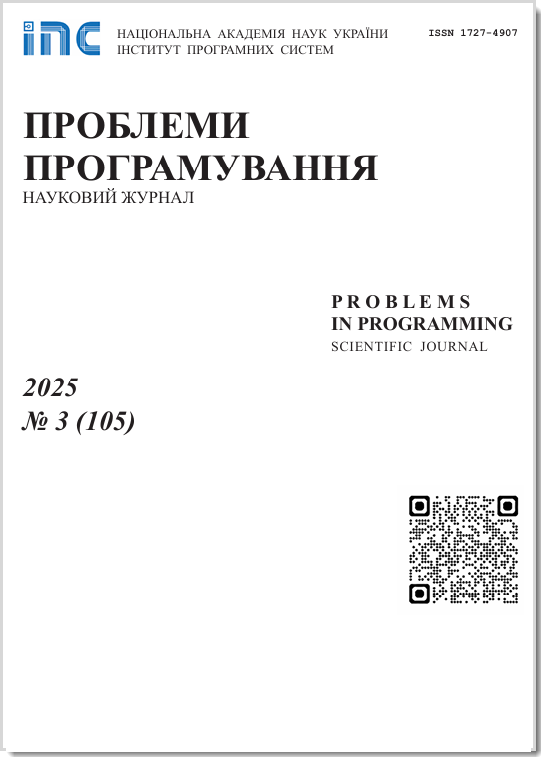Game theoretic modeling of AIMD network equilibrium
Abstract
This paper deals with modeling of network’s dynamic using game theory approach. The process of interaction among players (network users), trying to maximize their payoffs (e.g. throughput) could be analyzed using game-based concepts (Nash equilibrium, Pareto efficiency, evolution stability etc.). In this work we presented the model of TCP network’s dynamic and proved existence and uniqueness of solution, formulated payoff matrix for a network game and found conditions of equilibrium existence depending of loss sensitivity parameter. We consider influence if denial of service attacks on the equilibrium characteristics and illustrate results by simulations.
Prombles in programming 2016; 1: 116-128
Keywords
Full Text:
PDFReferences
Sandberg, Henrik, Saurabh Amin, and K. Johansson. Cyberphysical Security in Networked Control Systems: An Introduction to the Issue // Control Systems, IEEE 35.1. - 2015. - P. 20-23. CrossRef
Kelly, Frank P., Aman K. Maulloo, and David KH Tan. Rate control for communication networks: shadow prices, proportional fairness and stability // Journal of the Operational Research society. - 1998. - P. 237-252. CrossRef
Shakkottai, Srinivas, Srinivas Govindaraju Shakkottai, and Rayadurgam Srikant. Network optimization and control. Now Publishers Inc, 2008. CrossRef
Manshaei, Mohammad Hossein, et al. Game theory meets network security and privacy // ACM Computing Surveys (CSUR). - 2013. -45.3, 25. CrossRef
Liang Xiannuan, and Yang Xiao. Game theory for network security // Communications Surveys & Tutorials, IEEE. - 2013. -15.1. P. 472-486. CrossRef
La Richard J. Role of network topology in cybersecurity // Decision and Control (CDC). - 2014 IEEE 53rd Annual Conference on. IEEE, 2014. CrossRef
Kelly Frank P., Aman K. Maulloo, and David KH Tan. Rate control for communication networks: shadow prices, proportional fairness and stability // Journal of the Operational Research society. - 1998. - P. 237-252. CrossRef
Mo J., Walrand J. Fair end-to-end window-based congestion control // IEEE/ACM Trans-actions on Networking. - 2000. - 8. - P. 556-567. CrossRef
Paganini F., Doyle J.C., Low S.H. Scalable laws for stable network congestion control // Proc. of IEEE Conference on Decision and Control. - 2001. - 1. - P. 185-190.
Low S.H., Srikant R. A Mathematical Framework for Designing a Low-Loss, Low-Delay Internet // Network and Spatial Economics. - 2004. - 4 (1). - P. 75-102. CrossRef
Altman E. et al. The evolution of transport protocols: An evolutionary game perspective // Computer Networks. - 2009. - Т. 53, N 10. - С. 1751-1759. CrossRef
Smith John Maynard. Evolution and the Theory of Games. Cambridge university press, 1982.
Altman E., Bonneau N., Debbah M., Caire G. An evolutionary game perspective to ALOHA with power control, in: Proceedings of the 19th International Teletraffic Congress, Beijing, 29 August-2 September, 2005.
Papadimitriou Christos. Algorithms, games, and the internet // Proceedings of the thirty-third annual ACM symposium on Theory of computing. ACM, 2001. CrossRef
Han Zhu, et al. Game theory in wireless and communication networks. Cambridge University Press, 2012.
Ignatenko Oleksii, and Oleksandr Synetskyi. Evolutionary Game of N Competing AIMD Connections // Information and Communication Technologies in Education, Research, and Industrial Applications. Springer International Publishing. - 2014. - P. 325-342. CrossRef
Andon F.I., and Ignatenko O.P. Modeling conflict processes on the internet // Cybernetics and Systems Analysis. - 2013, 49.4. - P. 616-623. CrossRef
DOI: https://doi.org/10.15407/pp2016.01.116
Refbacks
- There are currently no refbacks.









